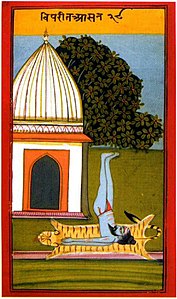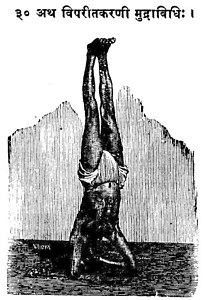Viparita Karani
Viparita Karani (
Etymology and origins
The name comes from the Sanskrit words विपरीत viparīta, "inverted" or "reversed", and करणी karaṇī, "a particular type of practice".[2]
The practice is described in the 13th century Vivekamārtaṇḍa (verses 103-131) as a means of yogic withdrawal, pratyahara.[3]
The pose was practised from the 17th century onwards in
-
Early Bindu Model of Hatha Yoga, as described in the Hatha Yoga Pradipika and other texts. Mudras such as Viparita Karani can reverse the flow, stopping the loss of vital fluid.[4]
-
Viparita Karani using aJoga Pradipika, 1830
-
Viparita Karani using a headstand in Yogasopana Purvacatuska, 1905
Description
Viparita Karani can be any practice where one is upside down. This can include the asanas of shoulder stand (
In one popular expression of Viparita Karani as an asana in
Variations
In Iyengar Yoga, the pose, also called "Legs-up-the-Wall Pose",[1] is described as "a restful practice, where the body is inverted without effort", and the lower back and buttocks are supported with a pile of blankets, while the legs are rested against a wall, either together or allowed to fall outwards into a straddle.[2]
In Uttanapadasana, meaning "feet up pose", the back rests on the floor and the legs point straight up, either against a wall, supported with a strap, or free.[2]
In Urdhva Prasarita Padasana, the back is on the ground, the arms are stretched out on the floor above the head, and the legs are raised either partly or to the vertical.[10]
In pregnancy, the pose can be practised as "Wall Butterfly", with the buttocks and feet against a wall, feet together as in Baddha Konasana, the knees falling to the sides. The hands can be used to press the knees.[11]
-
Uttanapadasana
References
- ^ a b Lee, Cyndi (25 August 2010). "Do Less, Relax More: Legs-up-the-Wall Pose". Yoga Journal. Retrieved 25 June 2021.
- ^ a b c Mehta 1990, p. 122.
- SOAS, University of London. Retrieved 14 November 2020.
- ^ a b Mallinson & Singleton 2017, pp. 32, 180–181.
- ^ Ghamande, Narayana (1905). Yogasopana Purvacatuska (1st ed.). Bombay: Janardan Mahadev Gurjar, Niranayasagar Press. p. 81.
- ^ Hatha Yoga Pradipika III.7
- ^ Hatha Yoga Pradipika III.5
- ^ Hatha Yoga Pradipika I.19
- ^ "Viparita Karani Mudra (Upside Down Seal)". Yoga Art and Science. Retrieved 21 August 2012.
- ^ Mehta 1990, p. 84.
- )
Sources
- OCLC 928480104.
- Mehta, Silva; Mehta, Mira; Mehta, Shyam (1990). )

![Early Bindu Model of Hatha Yoga, as described in the Hatha Yoga Pradipika and other texts. Mudras such as Viparita Karani can reverse the flow, stopping the loss of vital fluid.[4]](http://upload.wikimedia.org/wikipedia/commons/thumb/1/16/Early_Bindu_Model_of_Hatha_Yoga.svg/316px-Early_Bindu_Model_of_Hatha_Yoga.svg.png)





